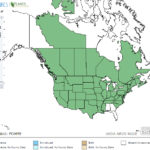Persicaria amphibia (Polygonum amphibium)
USDA, NRCS. 2018. The PLANTS Database (http://plants.usda.gov, 28 March 2018). National Plant Data Team, Greensboro, NC 27401-4901 USA.
Illustration: USDA-NRCS PLANTS Database / USDA NRCS. Wetland flora: Field office illustrated guide to plant species. USDA Natural Resources Conservation Service.
What is Longroot Smartweed?
Physical Characteristics
- 2 forms
Leaves:
- Floating
- Sword-shaped
- 2-5 inches long
- 0.39-2.36 inches wide
- Leaf stalks 0.78-1.5 inches long
Flowers:
Spikes:
Fruit:
- One seeded
- Does not open to release seed when ripe
- Round
- Bulging on both sides
- 0.11-0.16 inches long
- Blackish to deep reddish brown in color
- Shiny
Stem:
- Up to about 5 feet tall
- Swollen above nodes
Roots:
- Rooting at swollen nodes
Where Does it Grow?
Longroot smartweed can be found in ponds, rivers, lakes, streams, ditches, canals, marshes, swamps, and in mud in wet meadows.
Pros and Cons of Longroot Smartweed
Smartweed seeds are heavily consumed by ducks, small birds, and small mammals. Submerged portions of all aquatic plants provide habitats for many micro and macro invertebrates. These invertebrates in turn are used as food by fish and other wildlife species (e.g. amphibians, reptiles, ducks, etc). After aquatic plants die, their decomposition by bacteria and fungi provides food (called “detritus”) for many aquatic invertebrates.


